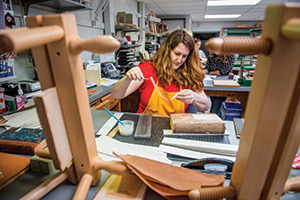 McComb
McComb
Tosha McComb, conservation technician for general collections at the Hesburgh Libraries, reattaches boards with toned Japanese paper and wheat starch paste. The paste is stable, alkaline and reversible in water. Modern resin-based adhesives are also used in repairing items in the circulating collections.
Conservation staff members pick up general circulation materials flagged as damaged or in need of repair weekly, and the books are triaged by the type of repairs needed — the case may be falling off, or the spine needs to be replaced. “We recreate custom spines and covers as well,” says conservator Sue Donovan. “We batch the circulating collections repairs to provide efficient and robust standardized treatments.” Other tasks include making book pockets to contain loose papers or errata that must stay with the volume.
Other jobs include mending, making protective boxes, making CoLibri covers — a trademarked system for making protective plastic covers for books — and sewing pamphlets into folders. The goal, Donovan says, is to make the circulating materials backpack-proof. “They get a lot of wear and tear.” Overall, the conservation lab strives to keep as much of the original book as possible, while strengthening and stabilizing the volume for use.
Conservation technician Diane Sikorski makes boxes for special collections. “We make our own alkaline card stock and cloth-covered clamshell boxes,” she says. She also makes plastic cradles to safely display books and other items for exhibitions in the gallery of Rare Books and Special Collections in the Hesburgh Library.